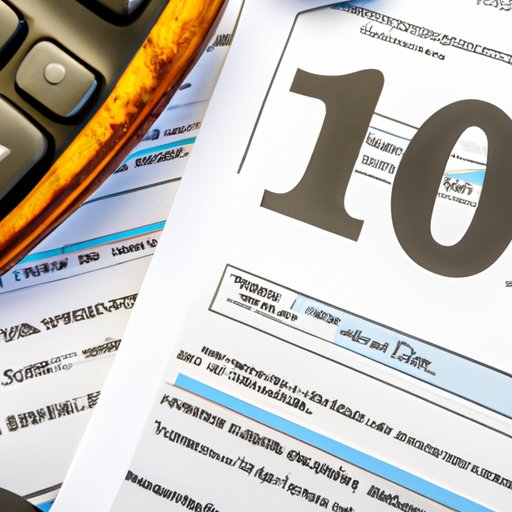Introduction
Tax season can be a confusing and overwhelming time for those who are not familiar with the various forms that must be completed. One of the most important forms to understand is the 1099, which is used to report income from sources other than traditional employment. In this article, we’ll explore what a 1099 is, how it works, and how to use it for tax purposes.
Explaining 1099 Basics: What is a 1099 & How Does it Work?
A 1099 is a form issued by businesses to independent contractors or freelancers. It is used to report the amount of income they earned in a given year. The Internal Revenue Service (IRS) uses the information reported on the 1099 to assess taxes owed. It’s important to understand the different types of 1099s and when to use them.
Definition & Overview of 1099s
The IRS defines 1099s as “information returns” that are used to report non-employee compensation. This includes income such as rental payments, royalties, prizes, awards, and more. The 1099 form is also used to report interest, dividends, and miscellaneous income.
Types of 1099 Forms & When to Use Them
There are several types of 1099 forms, each of which serves a different purpose. For instance, the 1099-MISC is used to report income from renting property or providing services as a freelancer. The 1099-INT is used to report interest income, while the 1099-DIV is used to report dividend income. Additionally, the 1099-G is used to report government payments, such as unemployment benefits.

What You Need to Know Before Filing a 1099
Before filing a 1099, it’s important to have all of the necessary information and documents. This includes the taxpayer’s name, address, Social Security number, and any other relevant information. Additionally, taxpayers should be aware of the various tax implications associated with filing a 1099, as well as the deadlines for filing.
Gathering Necessary Information & Documents
To file a 1099, taxpayers will need to gather the necessary information and documents. This includes the taxpayer’s name, address, Social Security number, and any other relevant information. Additionally, taxpayers should obtain copies of any documents related to the income being reported, such as invoices or contracts.
Understanding Tax Implications & Deadlines
It’s important to understand the potential tax implications associated with filing a 1099. Depending on the type of income being reported, taxpayers may be subject to various taxes, such as federal income tax, state income tax, and self-employment taxes. Additionally, taxpayers should be aware of the deadlines for filing 1099s, which vary depending on the type of form.

A Guide to Understanding 1099 Forms
Filing 1099 forms can be a daunting task, but understanding the basics of the form can make the process easier. In this section, we’ll examine each form in detail and discuss how to complete and submit it.
Examining Each Form & Its Uses
The 1099 forms can be divided into two categories: those used to report income and those used to report government payments. Each form has its own specific uses, so it’s important to understand which form to use for a particular situation. For example, the 1099-MISC is used to report income from rentals, services, and other sources, while the 1099-G is used to report government payments.
Completing the Form & Submitting It
Once the appropriate form has been determined, the next step is to complete and submit it. The form should be filled out accurately and completely, including all information requested. Once the form has been completed, it should be submitted to the IRS or other appropriate agency. Depending on the type of form, the submission process may involve paper filing or electronic filing.

How to File and Report 1099 Income
Filing and reporting 1099 income requires several steps. In this section, we’ll discuss the steps involved in filing and reporting 1099 income, as well as the differences between electronic filing and paper filing.
Steps for Filing & Reporting 1099 Income
The first step in filing and reporting 1099 income is to determine which form to use. Once the appropriate form has been determined, the next step is to gather the necessary information and documents. After the form has been completed, it should be submitted to the IRS or other appropriate agency. Finally, the taxpayer should report the 1099 income on their tax return.
E-filing vs. Paper Filing
Depending on the type of form, taxpayers may be able to e-file or paper file their 1099s. E-filing is generally the preferred method of submitting 1099s, as it is faster and more accurate than paper filing. However, some forms must be paper filed. Taxpayers should check with the IRS or other appropriate agency to determine which method of filing is required for a particular form.
Common Mistakes to Avoid When Filing 1099s
In order to ensure accuracy when filing 1099s, it’s important to avoid common mistakes. In this section, we’ll discuss some of the most common mistakes to avoid when filing 1099s.
Double-Checking All Information
One of the most important things to do when filing 1099s is to double-check all of the information. This includes the taxpayer’s name, address, Social Security number, and any other relevant information. Additionally, taxpayers should make sure that all forms are filled out accurately and completely.
Keeping Records of All Forms
Taxpayers should keep records of all forms they file, including 1099s. This is important for both the taxpayer and the IRS, as it can help ensure accuracy and help resolve any discrepancies that may arise. Additionally, keeping records of all forms can help taxpayers track their income and expenses throughout the year.
Using 1099s for Self-Employment Tax Purposes
For those who are self-employed, 1099s can be an invaluable tool. In this section, we’ll discuss the benefits of using 1099s for self-employment tax purposes, as well as how to calculate self-employment tax liability.
Benefits of Using 1099s for Self-Employment Tax
Using 1099s for self-employment tax purposes can be beneficial for taxpayers. By filing 1099s, taxpayers can get an accurate picture of their income and expenses, which can help them plan for taxes and other financial obligations. Additionally, 1099s can help taxpayers claim deductions and credits that may reduce their tax liability.
Calculating Self-Employment Tax Liability
Self-employment tax liability is calculated using the income reported on the 1099 forms. Taxpayers should subtract any deductions and credits from their total income to arrive at the net income figure. The self-employment tax rate is 15.3%, and the amount owed is calculated based on the net income figure.
Conclusion
Filing 1099s can be a confusing and intimidating task, but understanding the basics can make the process simpler. This article provided an overview of 1099s, what they are used for, and how to use them for tax purposes. We also discussed common mistakes to avoid when filing 1099s, as well as the benefits of using 1099s for self-employment tax purposes. For those who need additional assistance, there are numerous resources available online.
(Note: Is this article not meeting your expectations? Do you have knowledge or insights to share? Unlock new opportunities and expand your reach by joining our authors team. Click Registration to join us and share your expertise with our readers.)
